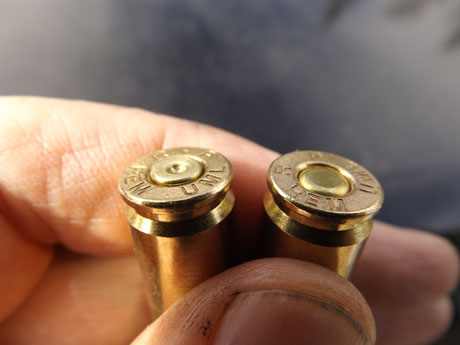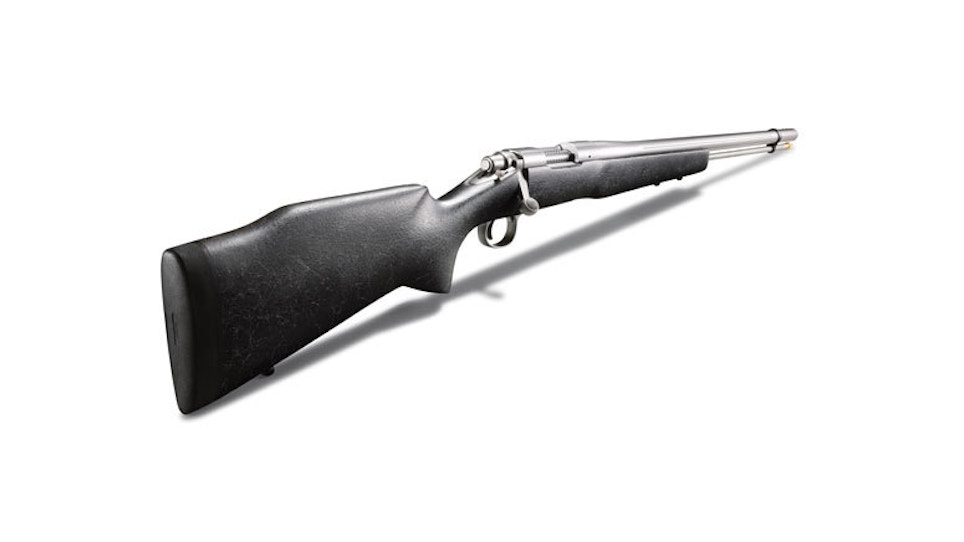North American hunters and shooters have had a long love affair with the Remington Model 700 rifle. It was first made available to the public in 1962 as a result of refinements made to the model 721 and 722 series of rifles, which were introduced in 1948. The 700 was intended to be mass produced, providing outdoorsmen and women with a simple design to appeal to the majority of users. It had good fit and a trigger to improve shooting skill and accuracy, and most of all, the rifle was accurate and dependable.
With 53 years of history in the modern firearm world, the Model 700 spans generations of hunters. Of course there have been a number of variations on the rifle action to appeal to varmint shooters, mountain hunters, big magnum enthusiasts, and even heavy-barreled target shooters. With more than 50 variations already on the market, the newest offering on the 700 platform is the Remington Model 700 Ultimate Muzzleloader. It isn’t exactly brand new, as Remington did bring a model 700 muzzleloader to consumers a few years back with obvious differences to accommodate an inline ignition system at the time.
Ignition

The 700 Ultimate Muzzleloader uses primed cases. You have to buy them from Remington, but they can be reprimed at home.
The new Ultimate Muzzleloader (UML) can boast it has a true model 700 action, as it uses primed centerfire brass casings for an ignition source. At first, one would think the design was a product of Remington’s research and development departments, but the truth is the technology is the same as that offered by Ultimate Firearms Inc. of Michigan, which has been building long-range front-stuffers for more than a decade. Also known as Johnston Muzzleloader, the company uses primed pistol brass for an ignition source, hot enough to burn a full 200 grains of powder.
The current Remington Model 700, released in April 2014, has the look and feel of a centerfire rifle, but is without doubt a muzzleloading firearm. The model 700 action uses a brass casing primed with a Remington 9½ large magnum rifle primer. It is basically a .308 cartridge casing cut down to load into the action of the UML as the ignition source. The casing is specifically designed to completely seal the flash hole, forcing the fire from the primer directly to your powder charge.
There are no replacements for the casing-specific ignition source for this gun. Remington sells the casings in bags of 24 for use specifically in the UML. The good news is you can re-prime the cases to use them again instead of purchasing the more expensive primed brass. The bolt is designed without an extractor that would throw the brass out of the gun. Instead, the casing is extracted and stays on the bolt face, making it easy to retrieve as it sits in the action for easy removal.
The primer casing is easy to load by dropping it in the action and locking it into place by simply pushing the bolt forward, then down. It is the same as loading a cartridge in a centerfire rifle.
Powder Charge And Effective Range
Remington recommends the use of Triple 7 powder for maximum powder burn and efficiency. It burns clean compared to other black powders or alternatives and still provides high energy. The pellets, specifically, have a hole through their center allowing the ignition flame to ignite all the pellets simultaneously. The fast burn would be essential to utilizing the entire 200 grains of powder before exiting the end of the barrel. What separates the UML from other modern inline rifles is it will shoot a full 200 grains of powder. Four 50-grain Triple 7 pellets can be loaded into the gun, producing velocities reported by Remington to achieve 2,400 fps. It claims to make the gun reliable to 300 yards.
I shot the rifle with four 50-grain Triple 7 pellets and a 250-grain Remington AccuTip bullet and obtained chronograph readings averaging 2,342 fps for three shots.
Velocity And What It Means
The average magnum load in a muzzleloader shooting 150 grains of Triple 7 or Pyrodex will produce bullet speeds of about 1,800 fps. The extra 542-plus fps is a significant boost in velocity, allowing this gun to easily shoot 300 yards with a lot of retained downrange kinetic energy. Remington recommends sighting the rifle for a 150-yard zero. That would mean the bullet is 1.5 inches high at 100 yards and 23.57 inches low at 300 yards. As you can see, all muzzleloaders have a horribly arcing trajectory that minimizes long-distance accuracy to some degree.
Look And Feel
The rifle has a clumsy appearance, but is designed to manage the recoil that 200-grains of propellant can produce. I’d compare the design to one of a Sendero rifle, used for long-range shooting on the open lines cut through mesquite brush in Texas and Mexico. A Sendero rifle is used as a heavy, stable platform to shoot long distances when required. They are meant to be shot from blinds or elevated platforms and not made to pack around in the mountains.
The UML rifle is 8 ½ pounds without a scope. Good optics would be a must if investing $1,000 or more in this rifle, making its working weight somewhere between 10 and 12 pounds. For a matter of fact, there is a Remington 700 Sendero rifle that also weighs 8 ½ pounds. The UML is a heavyweight in the muzzleloader world, sporting a length of pull of 13 3/8 inches, with an overall length of 47 inches. The one thing that makes it stand out from other smokepoles is the 1:26 rate of twist in the rifling. Most inline guns you look at will have a 1:28 rate of twist, but Remington managers told me a number of different twist rates and rifle profiles were tested and this is what they settled on. The 1:26 with a right or clockwise turn proved to be the most stable platform.
The modern gun has a 26-inch stainless steel barrel to make the gun easy to maintain and clean. A fluted barrel is aesthetically pleasing and helps to reduce the overall weight of the rifle. A rubber alignment ring is used to hold the ramrod under the barrel. Shaped like a figure 8, it fits tightly over the barrel, leaving a smaller bottom loop to tightly support the rod.
The gun is outfitted with a Bell and Carlson synthetic stock, which looks great and is easy to hold. The stock is heavy and wide on the forend with a slight comb present on the butt. A compressible recoil pad is included to help manage kickback. The stock is equipped with sling swivels and is recessed to accommodate a ramrod under the barrel. A wood laminate stock is also available.
The Remington receiver is machined from a solid bar of steel for uniformity and strength. It is one of the reasons the overall weight of the gun is heavier than average, but it is also the strength and backbone for taking the biggest powder charge seen in the industry from a mainstream manufacturer.
The bolt design is unlike any other muzzleloader. The face is deeply recessed into the bolt body, allowing the entire back end of the shell casing to be surrounded by rings of solid steel. The bolt has two large lugs that allow it to lock securely in place when closed. The bolt has historically been used to cycle cartridges from the magazine into the chamber, but in the case of the UML it is used to control blowback and pinpoint ignition. It is an open and closed case of strength and reliability.
Trigger
The wide blade trigger is easy to grip with your finger and remains firm to the breaking point without any sign of creep. Using a Timney Trigger pull scale, I took three trigger weights that averaged 3 pounds, 7 ounces. The weight was set at the factory. The trigger would be considered good for maximizing accuracy and consistency when shooting.
The X-Mark Pro Externally Adjustable Trigger can be set from 2 1/2 to 5 pounds, giving shooters the ability to set the pull to their safety standards and achieve maximum accuracy.
A floor plate release is located in the front of the trigger guard. Instead of housing cartridges to be cycled through the gun, the void holds foam-like material to house three extra primed casings. The internal storage is a good use of space and makes reloading quicker, knowing components are at your fingertips.
Accuracy
The rifle shot remarkably well. Using the recommended powder and bullet combinations from Remington, I shot a three-shot group measuring just over an inch at 100 yards. The gun was consistent and had well-managed recoil. I’d have to say that shooting four pellets did not have any more felt recoil than shooting three pellets out of other muzzleloaders on the market. I strongly believe the overall size and weight of the rifle is what makes it easy to shoot with the super magnum load.
Bullets
Remington recommends the use of its Premier AccuTip 250-grain bullet and sabot. It is a solid copper bullet with polymer tip for quick expansion and good weight retention. The sabots are deeply cupped on the bottom and lined with ridges to withstand the energy 200 grains of powder produces. A normal sabot would be destroyed by the same energy. Once again, having to purchase a specific product to use this rifle means planning ahead will be critical, as bullet and primer casing options cannot be substituted.
There is little doubt some hunters will be rushing out to get the biggest, baddest muzzleloader on the market, but it’s not for everyone. With a price tag starting at $1,200, consumers will find it an expensive purchase. To top things off, you’ll need to purchase Remington primed cases and bullets to have all the right components to get the most out of the gun. If you hunt in wide-open country, this gun could prove extremely useful. A significant amount of time will be required at the range in order to take advantage of the gun’s maximum performance. Shooters will quickly be able to determine the trajectory of the bullet at different ranges and make sound decisions for when to use the rifle while hunting.
With nearly 3.5 million Model 700s on the market since the first one was introduced, the UML will undoubtedly add to the impressive sales of the company. It is the most unique variation of the popular action, and accuracy out of the box will now depend on the user and the amount of time he or she spends becoming familiar with what the muzzleloading action 700 can do.






